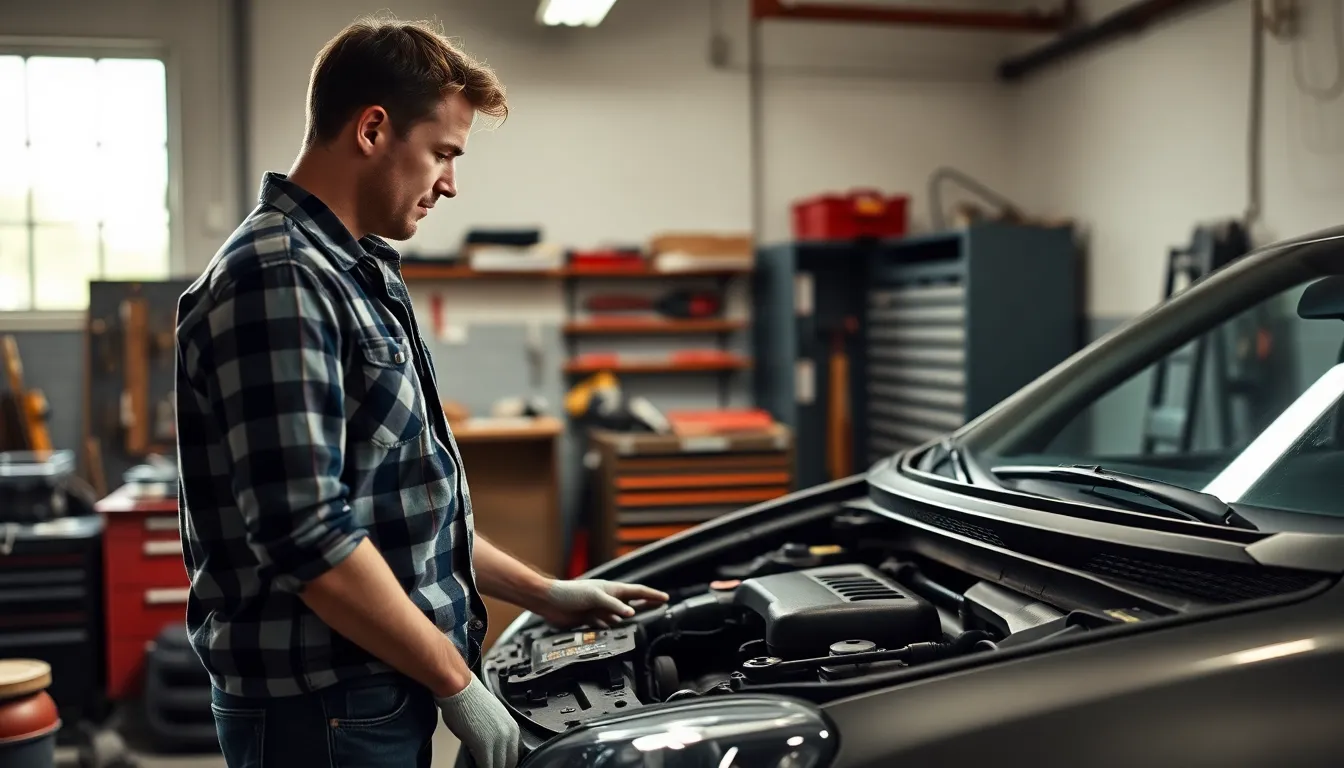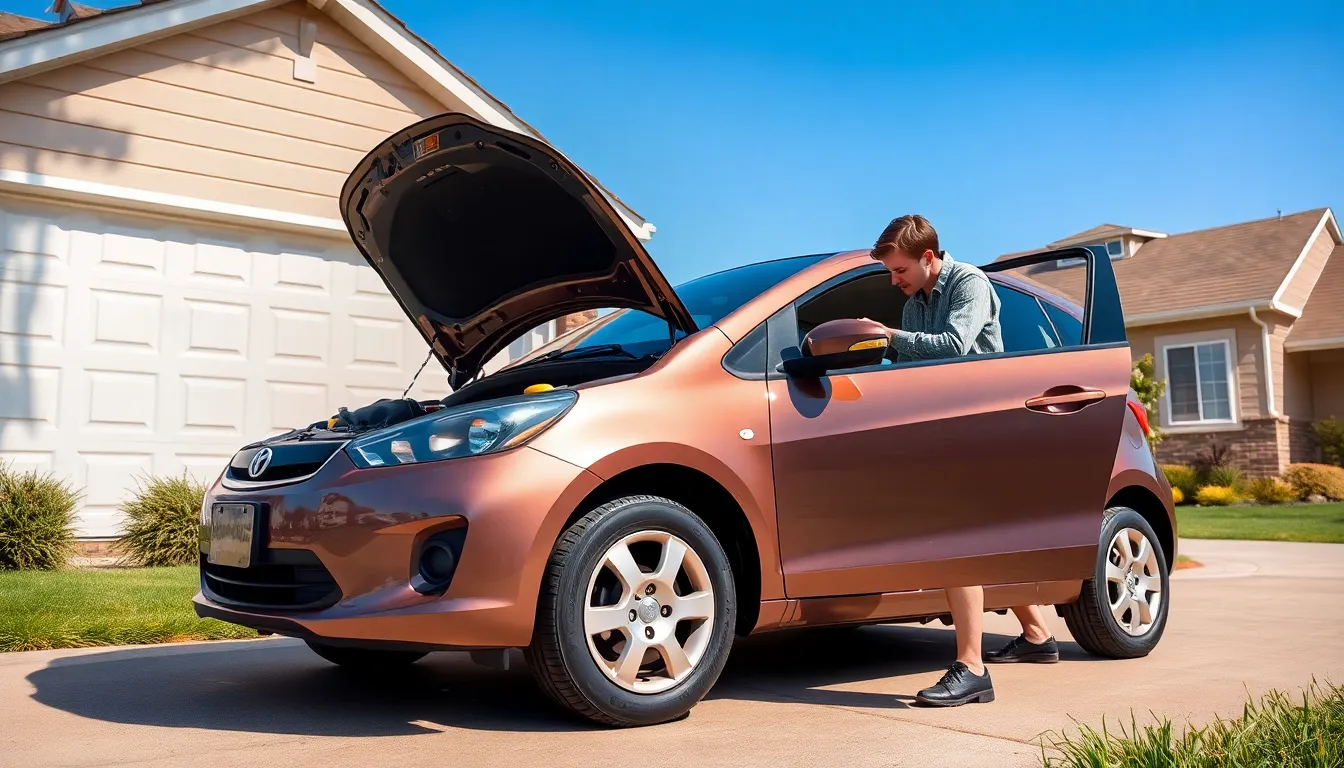We all remember that magical moment when we first got behind the wheel of our very own car. Whether it was a hand-me-down from family or something we saved every penny to buy, our first car represents so much more than just transportation – it’s freedom, independence and countless memories waiting to be made.
Choosing your first car can feel overwhelming with so many factors to consider. Budget constraints, insurance costs, reliability concerns and safety features all play crucial roles in this life-changing decision. We’ve been there and understand the excitement mixed with anxiety that comes with this milestone purchase.
That’s why we’re here to guide you through everything you need to know about finding the perfect first car. From practical tips on what to look for to common mistakes first-time buyers make, we’ll help you navigate this exciting journey with confidence and make a choice you’ll be happy with for years to come.
Choose the Right Budget for Your First Cars
Setting a realistic budget forms the foundation of smart first car shopping. We’ll break down the essential financial considerations to help you make an well-informed choice.
Determine Your Total Available Funds
Calculate your maximum spending limit by evaluating your savings, potential loan amount, and monthly payment capacity. Most financial experts recommend spending no more than 10-15% of your annual income on a vehicle purchase. We suggest creating a spreadsheet that includes your current savings, expected down payment, and realistic monthly payment you can afford without straining your budget.
Separate your purchase budget from your emergency fund to maintain financial stability after buying your first car. Keep at least $1,000-$2,000 in savings for unexpected expenses that inevitably arise with vehicle ownership. This safety net prevents you from going into debt when your car needs immediate attention.
Consider financing options carefully if you’re not paying cash upfront. Credit unions typically offer better interest rates than traditional banks for first time buyers, often providing rates 1-2% lower than dealership financing. Pre-approval gives you negotiating power and helps you understand your true buying capacity before stepping onto a car lot.
Factor in Insurance and Registration Costs
Research insurance rates before making your final decision since premiums vary significantly based on the vehicle’s make, model, and year. Sports cars and luxury vehicles typically cost 25-40% more to insure than sedans or compact cars. We recommend getting insurance quotes for 3-5 potential vehicles to compare costs accurately.
Budget for registration fees and taxes which can add $500-$1,500 to your initial purchase depending on your state’s requirements. Sales tax alone ranges from 2.9% to 11.5% depending on your location, while registration fees vary from $25 to $200 annually. These costs often surprise first time buyers who focus solely on the sticker price.
Add these recurring costs to your monthly budget calculations to get a complete picture of ownership expenses. Insurance for young drivers typically ranges from $150-$300 monthly, while registration and licensing fees require annual renewal. Factor these amounts into your ongoing transportation budget to avoid financial surprises.
Account for Maintenance and Repair Expenses
Set aside $1,200-$1,800 annually for routine maintenance including oil changes, tire rotations, brake inspections, and seasonal tune ups. Older vehicles with higher mileage may require $2,000-$3,000 yearly in maintenance costs, while newer cars typically need less frequent service. Create a separate savings account specifically for these predictable expenses.
Prepare for unexpected repair costs by researching common issues for your target vehicle models. Transmission repairs can cost $2,500-$4,000, while engine problems may require $3,000-$6,000 in parts and labor. We recommend having access to at least $2,000 for emergency repairs, either through savings or a dedicated credit line.
Choose reliable vehicle brands known for lower maintenance costs to minimize long term expenses. Toyota, Honda, and Mazda consistently rank among the most reliable manufacturers with average annual repair costs below $500. Luxury brands like BMW, Mercedes, and Audi typically require $1,200-$2,000 annually in maintenance, making them expensive choices for budget conscious first time buyers.
Research Reliable First Cars Models

Finding the right first car requires thorough research into proven models that balance affordability with dependability. We’ve identified the most reliable options that consistently deliver value for new drivers.
Focus on Honda Civic and Toyota Corolla
Honda Civic models consistently rank among the top choices for first-time buyers due to their exceptional reliability ratings and low maintenance costs. The Civic offers excellent fuel economy averaging 28-32 mpg in city driving and 36-40 mpg on highways. We recommend 2016-2020 model years as they provide modern safety features while remaining budget-friendly.
Toyota Corolla stands out as another bulletproof option with a reputation for lasting well beyond 200,000 miles with proper maintenance. These vehicles typically cost $2,000-3,500 less annually in maintenance compared to luxury brands. Insurance rates for both Civic and Corolla models remain affordable for young drivers, often 15-25% lower than sportier alternatives.
Both manufacturers offer comprehensive warranty coverage that extends peace of mind for first-time buyers. Honda provides a 3-year/36,000-mile basic warranty, while Toyota matches with similar coverage plus roadside assistance programs.
Consider Mazda3 and Nissan Sentra Options
Mazda3 delivers a premium driving experience without the premium price tag, featuring responsive handling and upscale interior materials typically found in luxury vehicles. The 2017-2021 model years offer excellent value with reliability scores matching Honda and Toyota competitors. Fuel efficiency reaches 26-28 mpg city and 35-36 mpg highway across most engine configurations.
Nissan Sentra provides spacious interiors and competitive pricing that often undercuts similar compact sedans by $1,500-2,500. The 2020 redesigned model features improved build quality and modern technology including standard automatic emergency braking. Maintenance costs remain reasonable with widely available parts and service locations.
Both alternatives offer unique advantages over traditional choices like enhanced technology features, sportier styling, and competitive financing rates through manufacturer programs.
Evaluate Certified Pre-Owned Vehicle Programs
Certified pre-owned programs provide additional security for first-time buyers who want newer features without new car prices. These vehicles undergo rigorous multi-point inspections covering engine, transmission, brakes, and safety systems before certification approval.
Extended warranty coverage typically includes powertrain protection for 7 years or 100,000 miles, plus roadside assistance and trip interruption benefits. Honda, Toyota, Mazda, and Nissan all offer comprehensive CPO programs with financing rates often matching new car incentives.
Vehicle history reports and detailed inspections eliminate guesswork about previous accidents or maintenance issues. We recommend comparing CPO options against similar private-party vehicles to determine the best value proposition for your exact situation.
Inspect Potential First Cars Thoroughly

We can’t stress enough how crucial a thorough inspection is when choosing our first vehicle. This step protects us from costly surprises and ensures we’re making a sound investment in our mobility.
Check the Vehicle History Report
We should always request a vehicle history report through Carfax or AutoCheck before purchasing any used car. This report reveals critical information about accidents, flood damage, previous owners, and maintenance records that sellers might not disclose.
Key items to look for include:
- Accident history with repair details
- Flood or fire damage indicators
- Number of previous owners (fewer is better)
- Service records and oil change frequency
- Title issues like salvage or lemon designations
We recommend avoiding vehicles with more than three previous owners or any history of major accidents. Cars with consistent maintenance records typically offer better long-term reliability and fewer unexpected repairs.
Examine the Engine and Transmission
We need to pop the hood and assess the engine’s overall condition during our inspection. Clean engine bays with minimal rust or corrosion indicate proper maintenance, while excessive grime or oil leaks signal potential problems.
Essential engine checks include:
- Oil level and color (should be relatively clean)
- Coolant levels and clarity
- Belt condition without cracks or fraying
- Battery terminals free from corrosion
- Unusual noises when running
Transmission inspection requires us to test both automatic and manual systems thoroughly. We should ensure smooth shifting without grinding, slipping, or delayed engagement that could indicate expensive transmission problems.
Test All Electrical Components and Features
We must verify that every electrical system functions properly since electrical repairs can be costly and complex. Modern cars rely heavily on electronic components that affect safety, comfort, and reliability.
Critical electrical tests include:
- All lights including headlights, taillights, and turn signals
- Air conditioning and heating systems
- Radio, speakers, and charging ports
- Power windows and door locks
- Dashboard warning lights and gauges
We should test these systems with the engine both running and off to identify any electrical drain issues. Malfunctioning electrical components often indicate deeper wiring problems that can lead to expensive diagnostic fees and repair costs down the road.
Negotiate the Best Deal on First Cars

Smart negotiation strategies can save us hundreds or even thousands of dollars on our first car purchase. We’ll explore proven techniques that give first-time buyers the confidence and knowledge needed to secure the best possible deal.
Research Market Values and Pricing
Understanding fair market value transforms us from vulnerable buyers into informed negotiators. We should start by checking multiple pricing sources including Kelley Blue Book, Edmunds, and Cars.com to establish a realistic price range for our target vehicle. These platforms provide separate values for trade-in, private party, and dealer retail prices.
Comparing similar vehicles in our local market reveals pricing patterns and negotiation opportunities. We need to search for at least 5-10 comparable cars within a 50-mile radius to understand regional pricing variations. Document the mileage, condition, and asking prices to build our negotiation ammunition.
Seasonal market trends significantly impact first car pricing and availability. We’ll find better deals during slower sales periods like late fall and winter months when dealers are motivated to clear inventory. Spring and summer typically bring higher prices as demand increases from new graduates and seasonal buyers.
Factory incentives and manufacturer rebates can substantially reduce our final purchase price. We should visit manufacturer websites and check for current cash back offers, low APR financing deals, or college graduate programs that apply to first-time buyers. These incentives stack with our negotiation efforts for maximum savings.
Prepare Your Financing Options in Advance
Securing pre-approved financing gives us tremendous leverage during price negotiations. We should apply for auto loans through credit unions, banks, and online lenders before stepping onto any car lot. Credit unions often offer the most competitive rates for first-time buyers with limited credit history.
Shopping multiple lenders allows us to compare interest rates and select the most favorable terms. We need to submit all loan applications within a 14-day window to minimize the impact on our credit scores. This strategy lets us present dealers with our best financing option as a starting point for negotiations.
Understanding total loan costs prevents dealers from manipulating monthly payment figures. We must focus on the vehicle’s sale price rather than just monthly payments, as dealers often extend loan terms to create misleadingly low monthly amounts. Calculate the total interest we’ll pay over the loan’s lifetime to make informed financing decisions.
Down payment preparation reduces our monthly obligations and strengthens our negotiating position. We should aim for at least 10-20% down payment to lower the loan amount and demonstrate financial responsibility to lenders. Having cash ready also gives us flexibility to negotiate better terms or walk away if needed.
Know When to Walk Away From a Bad Deal
Recognizing pressure tactics helps us avoid costly mistakes during our first car negotiation. We should immediately become cautious if dealers use phrases like “today only” pricing, refuse to provide written estimates, or pressure us to sign documents without review time. Legitimate dealers respect our need to make informed decisions.
Setting firm price limits before negotiations prevents emotional overspending. We need to determine our absolute maximum budget including taxes, fees, and extended warranties, then stick to this number regardless of sales pressure. Writing down our limits beforehand makes it easier to walk away when dealers exceed our boundaries.
Excessive fees and add-ons often signal a dealer trying to inflate profits unfairly. We should question any fee over $200 and refuse unnecessary products like extended warranties, fabric protection, or VIN etching that we can purchase elsewhere for less money. Documentation fees above $300 typically indicate dealer markup practices.
Alternative options always exist when current negotiations reach an impasse. We can explore other dealerships, consider certified pre-owned programs, or wait for better seasonal pricing if current deals don’t meet our requirements. Having backup vehicles identified gives us confidence to walk away from unfavorable negotiations.
Understand Insurance Requirements for First Cars

Insurance costs can significantly impact your overall budget and monthly expenses when purchasing your first vehicle. We’ll explore essential strategies to secure affordable coverage while maintaining adequate protection.
Compare Quotes From Multiple Providers
Shopping around for insurance quotes can save you hundreds of dollars annually on your first car coverage. We recommend contacting at least three to five different insurance companies to compare rates and coverage options. Major providers like State Farm, Geico, Progressive, and Allstate often offer competitive rates for new drivers.
Age and driving experience directly influence your insurance premiums as a first-time car owner. Teen drivers typically face the highest rates, with annual premiums ranging from $3,000 to $7,000 for full coverage. Young adults aged 20-25 can expect to pay approximately $2,000 to $4,000 per year for comprehensive coverage.
Online comparison tools streamline the quote-gathering process and help identify the best deals. Websites like Compare.com, Insurance.com, and The Zebra allow you to input your information once and receive multiple quotes simultaneously. Independent insurance agents can also provide quotes from various carriers and offer personalized guidance for first-time buyers.
Bundling policies with existing family coverage often results in substantial savings for new drivers. Many insurers offer multi-car discounts of 10-25% when you add your vehicle to a parent’s existing policy. Student discounts, good driver programs, and loyalty rewards can further reduce your premium costs.
Consider Adding Safety Features for Discounts
Modern safety features can significantly reduce your insurance premiums while protecting you on the road. Anti-lock braking systems (ABS), electronic stability control, and multiple airbags are standard features that many insurers recognize with discounts ranging from 5-15%.
Advanced driver assistance systems provide additional savings opportunities for first-time car buyers. Features like automatic emergency braking, blind-spot monitoring, and lane departure warnings can qualify for discounts of 10-20% with participating insurance companies. Backup cameras and parking sensors also contribute to lower premium rates.
Anti-theft devices and security systems offer another avenue for insurance savings. Factory-installed alarm systems, immobilizers, and GPS tracking devices can reduce your comprehensive coverage costs by 5-10%. Some insurers provide additional discounts for vehicles equipped with LoJack or similar recovery systems.
Defensive driving courses demonstrate your commitment to safe driving and often qualify for insurance discounts. Many providers offer 5-15% premium reductions for completing approved defensive driving programs. These courses are particularly valuable for young drivers seeking to offset higher base rates.
Understand Coverage Types and Deductibles
Liability coverage represents the minimum legal requirement in most states and protects you from financial responsibility for damages to others. State-mandated minimums vary significantly, with some requiring as little as $25,000 per person for bodily injury liability. We recommend purchasing higher limits of $100,000/$300,000/$100,000 to ensure adequate protection.
Collision coverage pays for damage to your vehicle in accidents, regardless of fault determination. This coverage becomes essential when financing or leasing your first car, as lenders typically require it. Deductibles typically range from $250 to $1,000, with higher deductibles resulting in lower monthly premiums.
Comprehensive coverage protects against non-collision damages like theft, vandalism, and weather-related incidents. This coverage proves particularly valuable for first-time buyers who can’t afford to replace their vehicle out of pocket. Glass coverage and rental car reimbursement are often included in comprehensive policies.
Deductible selection directly impacts both your premium costs and out-of-pocket expenses during claims. Choosing a $500 deductible instead of $250 can reduce your premium by 15-30% annually. But, ensure you can comfortably afford your chosen deductible amount in case of an accident or covered loss.
| Coverage Type | Typical Cost Range | Recommended Minimum |
|---|---|---|
| Liability | $400-$800/year | $100,000/$300,000 |
| Collision | $300-$600/year | $500 deductible |
| Comprehensive | $150-$400/year | $500 deductible |
| Uninsured Motorist | $100-$300/year | State minimum |
Master Essential Maintenance for First Cars

Regular maintenance keeps your first car running smoothly and prevents costly repairs down the road. Building these habits early will save you thousands of dollars over your vehicle’s lifetime.
Learn Basic Fluid Checks and Changes
Engine oil changes form the foundation of proper vehicle maintenance and should occur every 3,000 to 5,000 miles depending on your car’s specifications. Check your owner’s manual for the exact interval, as newer vehicles often require synthetic oil that lasts longer between changes. Most quick-lube shops charge $30-60 for standard oil changes, while synthetic oil services cost $60-100.
Coolant levels require monthly inspection to prevent engine overheating, which can cause damage costing $1,500-3,000 to repair. Look for the coolant reservoir tank near your radiator and ensure the fluid level stays between the minimum and maximum marks. Replace coolant every 30,000-50,000 miles or every 3-5 years to maintain optimal engine temperature regulation.
Brake fluid needs attention every 2-3 years since contaminated fluid reduces braking effectiveness and can lead to brake system failure. Locate the brake fluid reservoir on the master cylinder and verify the fluid appears clear rather than dark or cloudy. Professional brake fluid replacement typically costs $80-120 and prevents expensive brake system repairs.
Transmission fluid keeps your gears shifting smoothly and should be checked monthly using the dipstick method while the engine runs. Bright red fluid indicates good condition, while dark or burnt-smelling fluid signals the need for immediate replacement. Transmission repairs can cost $2,000-4,000, making regular fluid maintenance crucial for first-time car owners.
Understand Tire Care and Rotation Schedules
Tire rotation every 5,000-7,500 miles ensures even wear patterns and extends tire life by 20,000-30,000 miles. Follow your vehicle’s recommended rotation pattern, typically moving front tires to the back and crossing rear tires to opposite front positions. Most tire shops perform rotations for $25-50, while learning to do it yourself saves money over time.
Proper tire pressure improves fuel economy by up to 3% and prevents premature tire wear that costs hundreds in early replacements. Check pressure monthly using a digital gauge when tires are cold, and maintain the PSI level listed on your driver’s side door jamb sticker. Underinflated tires reduce fuel efficiency and create dangerous blowout risks.
Tread depth monitoring prevents dangerous driving conditions and helps you plan for tire replacement before emergency situations arise. Use the penny test by inserting Lincoln’s head into tire grooves upside down – if you see the top of his head, you need new tires. Quality tires for compact cars typically cost $400-800 for a complete set.
Seasonal tire considerations become important in regions with harsh winters, where all-season tires may not provide adequate traction below 45°F. Winter tires improve stopping distance by 30-40% in snow and ice conditions but require storage space and seasonal mounting. Budget $600-1,200 for a winter tire set plus mounting costs.
Establish Relationships With Trusted Mechanics
Research local mechanics before you need repairs by reading online reviews, checking Better Business Bureau ratings, and asking friends for recommendations. Look for ASE-certified technicians who specialize in your car’s make and model, as they’ll understand common issues and have appropriate diagnostic tools. Independent shops often charge 20-30% less than dealerships for routine maintenance.
Build rapport gradually by starting with simple services like oil changes or tire rotations before trusting major repairs to a new shop. Observe how staff explains procedures, provides estimates, and treats your vehicle during service appointments. Mechanics who take time to educate first-time car owners about maintenance typically provide more honest service.
Understand warranty implications when choosing between dealership service and independent mechanics for maintenance on newer vehicles. Dealerships often charge premium prices but maintain detailed service records that protect your warranty coverage. Independent mechanics can perform most maintenance tasks without voiding warranties, saving 30-50% on service costs.
Establish maintenance schedules with your chosen mechanic to ensure regular service intervals don’t slip through busy schedules. Many shops offer reminder calls or text messages for oil changes, inspections, and seasonal maintenance tasks. Creating consistent service relationships helps mechanics spot potential problems early and provide personalized recommendations for your driving habits.
Avoid Common First Cars Buying Mistakes

Making informed decisions during your first car purchase protects you from expensive regrets and ensures long-term satisfaction with your investment.
Don’t Skip the Pre-Purchase Inspection
Comprehensive inspection services save first-time buyers thousands of dollars by revealing hidden problems before purchase. Many new buyers overlook this crucial step and face unexpected repair bills within weeks of buying their first car.
Professional mechanics can identify issues that untrained eyes miss during casual walkthroughs. Schedule inspections with qualified technicians who specialize in pre-purchase evaluations and can provide detailed reports about the vehicle’s condition.
Engine diagnostics reveal problems with critical systems that could lead to expensive failures. Request mechanics to check compression levels, transmission fluid quality, and electrical system functionality during their assessment.
Body damage assessment uncovers collision history that sellers might not disclose honestly. Look for misaligned panels, paint color variations, and rust spots that indicate previous accidents or poor maintenance practices.
Inspection costs typically range from $100 to $200 but can prevent purchases of vehicles needing thousands in immediate repairs. Budget this expense into your car-buying process as essential protection rather than an optional service.
Avoid Emotional Decision Making
Impulse purchases lead to poor financial decisions when buyers fall in love with cars beyond their realistic budgets. Set firm spending limits before visiting dealerships and stick to predetermined numbers regardless of sales pressure or attractive features.
Seller pressure tactics exploit emotional responses by creating false urgency around “limited time” offers or “other interested buyers.” Take time to research, compare options, and never sign contracts during your first visit to any seller.
Feature priorities should focus on reliability and affordability rather than impressive technology or appearance upgrades. List essential requirements versus nice-to-have amenities before shopping to maintain clear decision-making criteria.
Budget boundaries protect first-time buyers from overextending financially on monthly payments or total purchase prices. Calculate total ownership costs including insurance, maintenance, and fuel expenses before committing to any vehicle.
Comparison shopping prevents hasty decisions by allowing evaluation of multiple vehicles within your price range. Visit at least three different sellers or dealerships to understand market pricing and available options thoroughly.
Never Ignore Red Flags During Test Drives
Strange noises during test drives indicate potential mechanical problems that require immediate professional attention. Listen carefully for grinding sounds from brakes, unusual engine rattling, or transmission shifting difficulties.
Warning lights on the dashboard signal system malfunctions that could lead to expensive repairs or safety hazards. Check that all warning indicators turn off after engine startup and don’t illuminate during normal driving conditions.
Steering problems create safety risks and suggest suspension or alignment issues requiring costly professional repairs. Test steering responsiveness, wheel vibration, and vehicle tracking to ensure safe handling characteristics.
Brake performance must feel confident and responsive throughout the entire test drive experience. Apply brakes gradually and firmly to check for squealing, grinding, or pedal softness that indicates worn components.
Transmission behavior should demonstrate smooth shifting in automatic vehicles and proper clutch engagement in manual transmissions. Avoid vehicles with delayed shifting, slipping sensations, or difficulty captivating gears during operation.
Plan for Long-Term Ownership of First Cars

Planning for the long haul ensures your first car serves you well beyond the initial purchase excitement. Smart ownership strategies protect your investment and keep you driving safely for years.
Build an Emergency Repair Fund
Setting aside money for unexpected repairs prevents financial stress when your first car needs major work. We recommend saving $50-100 monthly into a dedicated repair fund starting immediately after your purchase.
Major components like transmissions and air conditioning systems can fail without warning, often costing $1,500-3,000 to repair. Your emergency fund should target 10-15% of your car’s value within the first year of ownership.
Older vehicles require larger emergency funds since parts become harder to find and labor costs increase. Aim for $2,000-3,000 in repair savings if your first car is over 10 years old.
Consider high yield savings accounts or money market accounts to grow your emergency fund while keeping it accessible. These accounts typically earn 4-5% annual interest compared to traditional savings accounts at 0.5-1%.
Keep Detailed Maintenance Records
Documenting every service and repair protects your first car’s resale value and helps identify patterns in maintenance needs. We suggest creating a simple spreadsheet or using apps like CarFax Car Care to track all work performed.
Record the date, mileage, service type, parts replaced, and cost for every maintenance visit. Include oil changes, tire rotations, brake inspections, and any repairs to build a comprehensive history.
Maintenance records increase your car’s resale value by 10-15% when you’re ready to sell or trade. Potential buyers pay premium prices for vehicles with documented care histories.
Save all receipts and service documentation in a dedicated folder or digital storage system. Warranty claims often require proof of regular maintenance, making detailed records essential for coverage.
Track recurring issues to spot potential problems before they become expensive repairs. Three brake pad replacements in two years might indicate alignment issues or driving habits that need adjustment.
Know When It’s Time to Upgrade
Recognizing upgrade timing prevents you from throwing good money after bad on an aging first car. We recommend evaluating your vehicle’s condition annually after the third year of ownership.
Calculate your total annual repair costs and compare them to 50% of your car’s current value. Spending more than half your car’s worth on repairs signals it’s time to start shopping for a replacement.
Major system failures like engine or transmission problems often cost more to fix than the car is worth. Get repair estimates from trusted mechanics before deciding whether to fix or replace your vehicle.
Consider your changing lifestyle needs when planning upgrades. Growing families, longer commutes, or career changes may require different vehicle features than your first car provided.
Fuel efficiency improvements in newer models can offset monthly payments through gas savings. Trading a 20 mpg first car for a 35 mpg replacement saves $100-150 monthly in fuel costs.
Safety technology advances every few years, making newer vehicles significantly safer than older models. Features like automatic emergency braking and blind spot monitoring weren’t available on many first cars from the 2010s.
Conclusion
Your first car represents more than just transportation—it’s your gateway to independence and countless adventures ahead. We’ve walked through every crucial step from setting realistic budgets to mastering essential maintenance that’ll keep your investment running smoothly.
Remember that patience and thorough research will serve you far better than rushing into any deal. Take time to inspect potential vehicles carefully and don’t hesitate to walk away if something doesn’t feel right.
The strategies we’ve shared—from smart negotiation tactics to building emergency repair funds—will help you avoid common pitfalls that catch many first-time buyers off guard. Your diligence now will pay dividends for years to come.
Most importantly trust your instincts throughout this process. With the knowledge you’ve gained here you’re well-equipped to find a reliable first car that fits both your budget and your dreams of the open road.
Frequently Asked Questions
What’s the ideal budget for a first car?
Experts recommend spending no more than 10-15% of your annual income on your first vehicle. Remember to separate your purchase budget from emergency funds and factor in additional costs like insurance, registration, taxes, and ongoing maintenance expenses when determining your total budget.
Which car models are best for first-time buyers?
The Honda Civic and Toyota Corolla are top choices due to their exceptional reliability, low maintenance costs, and affordable insurance rates. The Mazda3 and Nissan Sentra are also excellent alternatives, offering enhanced technology features and competitive pricing for budget-conscious buyers.
Should I buy new or used for my first car?
Used cars are typically recommended for first-time buyers due to lower purchase prices and insurance costs. Consider certified pre-owned (CPO) vehicles for added security, as they include rigorous inspections and extended warranty coverage while avoiding new car depreciation.
What should I inspect before buying a used car?
Always request a vehicle history report and thoroughly inspect the engine, transmission, brakes, tires, and electrical systems. Check oil levels, listen for unusual noises, test all electronic components, and look for signs of accidents or poor maintenance. Consider hiring a professional mechanic for inspection.
How can I get affordable car insurance as a first-time buyer?
Shop around and compare quotes from multiple insurance providers, as rates can vary significantly. Consider bundling with family policies, take advantage of safety feature discounts, and use online comparison tools. Maintaining good grades (for students) can also qualify you for additional discounts.
What maintenance should I expect for my first car?
Budget for regular oil changes every 3,000-5,000 miles, tire rotations every 6,000-8,000 miles, and routine fluid checks. Set aside $50-100 monthly for an emergency repair fund, targeting 10-15% of your car’s value within the first year for unexpected maintenance costs.
How do I negotiate the best price on my first car?
Research market values using Kelley Blue Book and Edmunds before shopping. Get pre-approved financing from credit unions for better leverage. Focus on total loan costs rather than monthly payments, prepare a 10-20% down payment, and be prepared to walk away from deals that exceed your budget.
What are the most common first-time buyer mistakes?
Skipping professional pre-purchase inspections, making emotional decisions under sales pressure, and forgetting to budget for insurance and maintenance costs. Avoid focusing solely on monthly payments instead of total costs, and don’t rush into purchases without proper research and comparison shopping.

